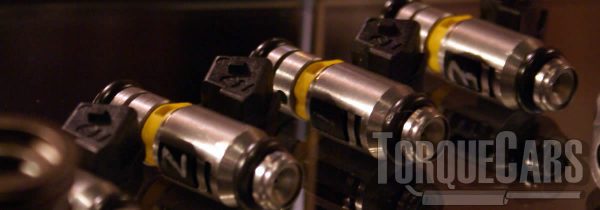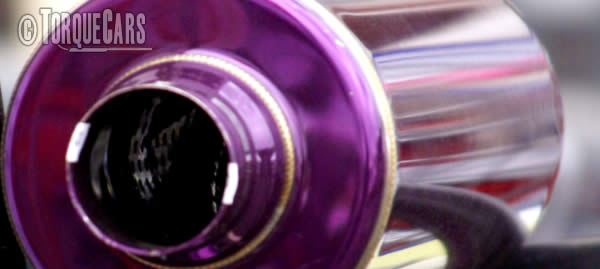Tuning the Rover 45
"Thanks for reading this Rover 45 tuning article."
The 45 is a good car modification project to fill your spare time. With the right mods your 45 can be transformed into an awesome motor. Don't waste money, do your homework and follow our unbiased guides to each performance upgrade to avoid disappointment.
TorqueCars will examine the options for your 45 tuning and highlight the best mods that work. Rover 45 are good project cars and with a few sensible modified upgrades like ECU maps, turbo upgrades and camshafts you will substantially increase your driving experience.

Handling/Suspension upgrades
Many 45 owners uprate the handling of their cars with uprated suspension modifications as a priority, this will certainly increase your enjoyment of the car.
Putting a tiny bit of negative camber on the wheels and around 1 to 1.7 degrees of toe in to improve stability or toe out for better cornering, will usually enhance your 45 in handling and cornering.
We would go to a maximum drop of 24mm - 39 mm. on most models. You risk compromising your handling if you go lower than this.
A nice wide torque band and sweet spot of peak power at one third of your RPM range is optimum.
Smaller engines do not provide much of a return in terms of power so start with a bigger engine. Engine swaps are a good option if you have a small engine size.
Engine Tuning.
These are the uprated modifications are usually installed by our members, decide how far you want to go before you get going.
Rover 45 (1999–2005)
- 1.4 L K-Series I4 (petrol)
- 1.6 L K-Series I4 (petrol)
- 1.8 L K-Series I4 (petrol)
- 2.0 L KV6 V6 (petrol)
- 2.0 L L-Series I4 (diesel)
A swap between the 1.4 and 1.8 was often done, and the 2.0T Tomcat really made this a fast car but not one of the easiest conversions to pull off.
Getting the best modified mods for your planned usage of the car is a time and money saver. Stage 3 competition upgrades just don't work well on the road making the car difficult to drive.
Please watch our introduction Video tutorial to car tuning. Be sure to subscribe and support our new channel.
How to tune your car
- Improve the handling
Focus on Suspension improvements, such as coilovers and make sure the bushings are in good order and that the alignment is correct. Then focus on improving the brakes, with a big disk brake conversion kit and fast road brake pads.
- Remove restrictions
Focus on the intake and exhaust with filters being the common point of restriction in a tuned car. Intercoolers may also become restrictive on turbo engines so this may also need to be uprated.
- Burn more fuel & air
Increase the fuelling so it matches the air coming into the engine. The ratio is important so you need to improve the fuel pump and injectors, so the head mods, big valve conversions, fast road camshafts and forced induction upgrades extra supply of air is adequately met.
- Test and replace any weak parts
Weak areas are commonly the clutch, the turbocharger and pistons and crankshaft in a highly tuned engine. Makes sure these components will cope with your power aspirations.
- The Tune or Remap
A cars ECU controls the fuel, timing, spark and even the turbo in some cases, so to fully extract your gains you should remap the car last and this will fully release the power. Some cars are easy to map, and others require piggyback ECU's or aftermarket ECU's but this is the most vital step of your tuning project.
Modifying to Stage 1:
Lighter flywheel, Sports exhaust, Panel air filter, Remap, Alloy wheels, Suspension upgrade (drop 24mm - 39 mm.).
Modifying to Stage 2:
fuel pump upgrades, Ported and polished head, high flow fuel injector, Power/Sport clutch, Fast road cam.
Modifying to Stage 3:
Internal engine upgrades (pistons/head/valves), Engine balancing, Sports gearbox, Competition cam, Adding or upgrading forced induction (turbo/supercharger).
Your goal when modding your car should be a wide torque curve. You don't want all the power to be at the top end unless you are creating a competition car.
When it comes to remapping it's not easy, as the Rover MEMS could not be remapped, but piggyback ECU's are around, ICON RACE was one we used.
In this article we shall give your a good starting base to the best performance parts for your car, but we'd encourage you to spend some time on the site looking into the details of each type of performance modification.
Fast road cams offer one of the biggest torque gains for your money as far as a solitary performance upgrades goes on a NASP engine.
It improves the intake and exhaust durations and increases the power if done right. Ideally you'd add other mods and finish up with a reflashed ECU.
We'd also caution you not to go with a motor sport cam as this affects the engines idling and general town driving characteristics.
When pushing up the power you will need to uprate to the fuelling. More power needs more fuel.
Frequently power losses, flat spots and erratic idling after performance parts are done can usually be traced to timing or fuelling issues.  Uprating the injectors is another beneficial modification and will deliver sufficient fuel.
Uprating the injectors is another beneficial modification and will deliver sufficient fuel.
A fuel pump will only deliver a finite amount of fuel, so you may need to uprate this if your injectors are demanding more fuel.
Intake and Exhaust Tuning.
The next area for modification is the intake and exhaust.  Please note that WE DO NOT RECOMMEND INDUCTION KITS, unless you have tuned your car a lot and are finding that the standard air intake has become limited.
Please note that WE DO NOT RECOMMEND INDUCTION KITS, unless you have tuned your car a lot and are finding that the standard air intake has become limited.

For most 45 engines TorqueCars would suggest you just go with a washable panel air filter. On heavily tuned engines and turbo vehicles an induction kit will help release the power providing you address the problem of supplying cold air.
Sports exhausts will certainly help air flow from the engine but avoid an exhaust that is too wide or you may end up will reduce the flow rate. Stick to 1.5 to 2.5 inches for best results.
Airflow through the head can be dramatically increased with some professional polishing and ported. These should match and be setup to take into account any other engine mods. A good heavy duty fast road upgraded clutch will help to keep that power going where it should. Never skimp or expect a standard clutch to cope. The best mods in our experience for your 45 are Remapping or piggy back ecu, fast road cam and air intake and exhaust.
Remaps offer big power gains on all turbo charged cars. On NASP engines the benefits are doubtful. However a remapped ECU on a NASP engine will help unleash the potential if you have done a lot of mods.
We've also seen some tuners toying with twincharging conversions and making some very high power hikes.
Adding forced induction will see massive power gains but this is usually too expensive to be cost effective. Superchargers are generally easier to add than a turbo. It is harder to map a turbo as the boost comes on exponentially with rpm.
It is more straightforward to map a supercharger because the boost is directly proportional to engine speed on a linear curve. Alternatively you could perhaps add water injection to cut down knock.
Alloy wheel upgrades.
As alloys are less heavy they improve performance and they help to cool the brake disks. Further improvements can be made to your cars handling with the addition of soft compound tire. Large 45 alloy wheels can decrease performance. If you get big alloy wheels you will be changing your final drive ratio.
Although some people have fitted larger wheels without problems we would stick to a 17 inch rim size as the maximum.
For more information on Tuning your car please join us in our friendly forum where you can discuss 45 options in more detail with our 45 owners. It would also be worth reading our unbiased Rover tuning articles to get a full grasp of the benefits and drawbacks of each modification.
Please help us improve these tips by sending us your feedback in the comments box below.
We love to hear what our visitors have got up to and which mods work best for them on each model of car. Comments are used to improve the accuracy of these articles which are continually updated.
If you liked this page please share it with your friends, drop a link to it in your favourite forum or use the bookmarking options to save it to your social media profile.
Check out TorqueCars new YouTube channel, and see their awesome new content...
Feedback
Please use our forums if you wish to ask a tuning question, and please note we do not sell parts or services, we are just an online magazine.
Help us improve, leave a suggestion or tip
